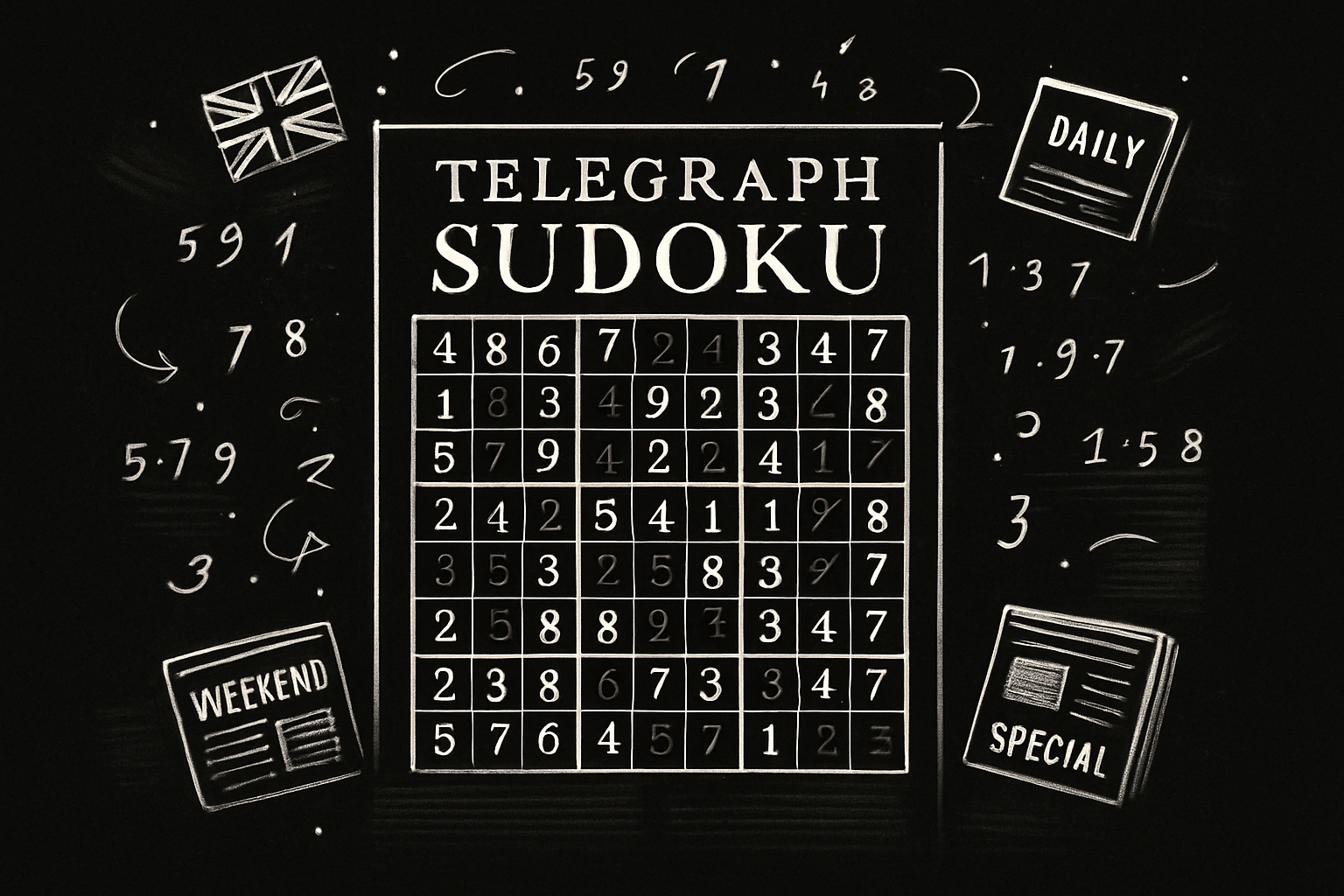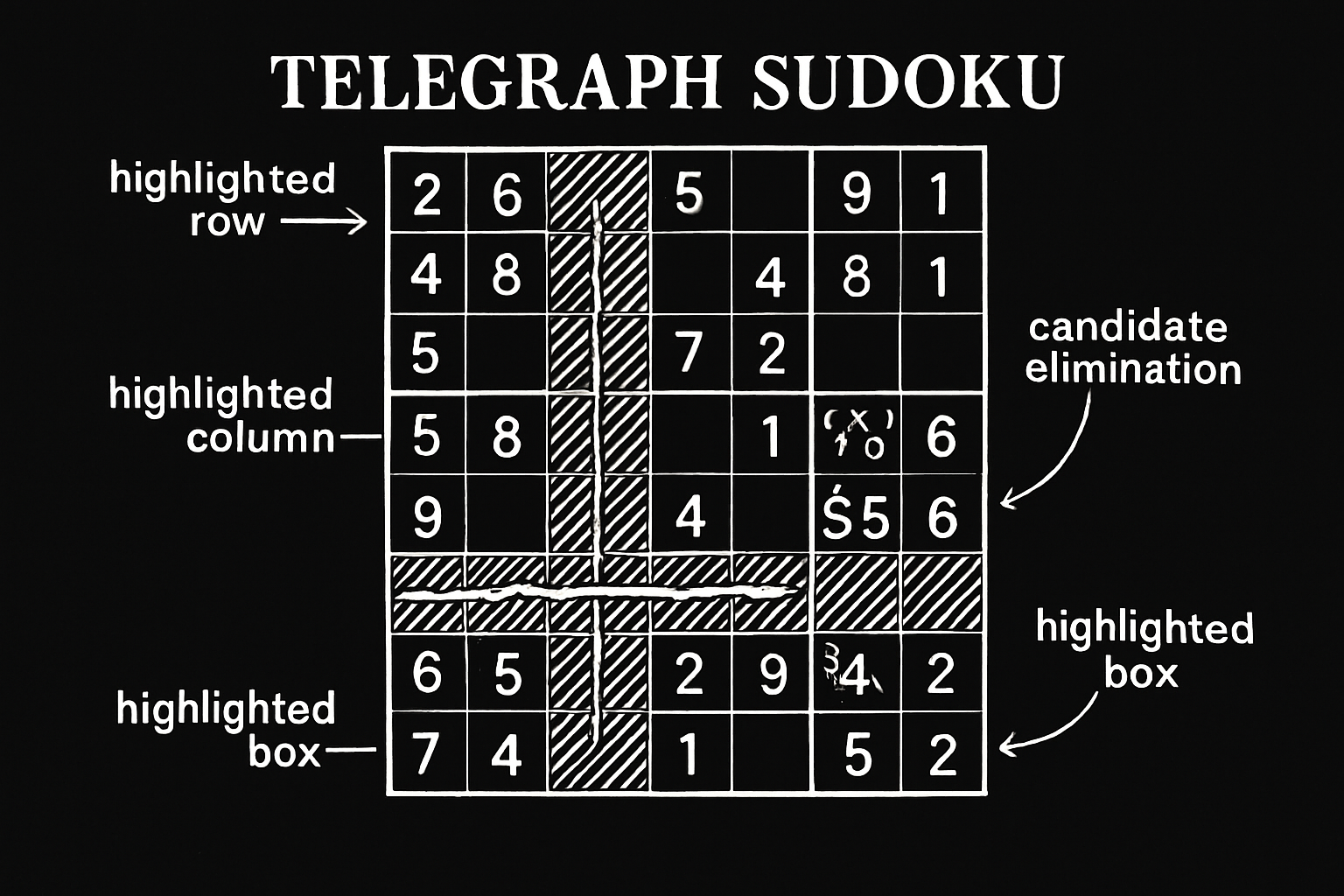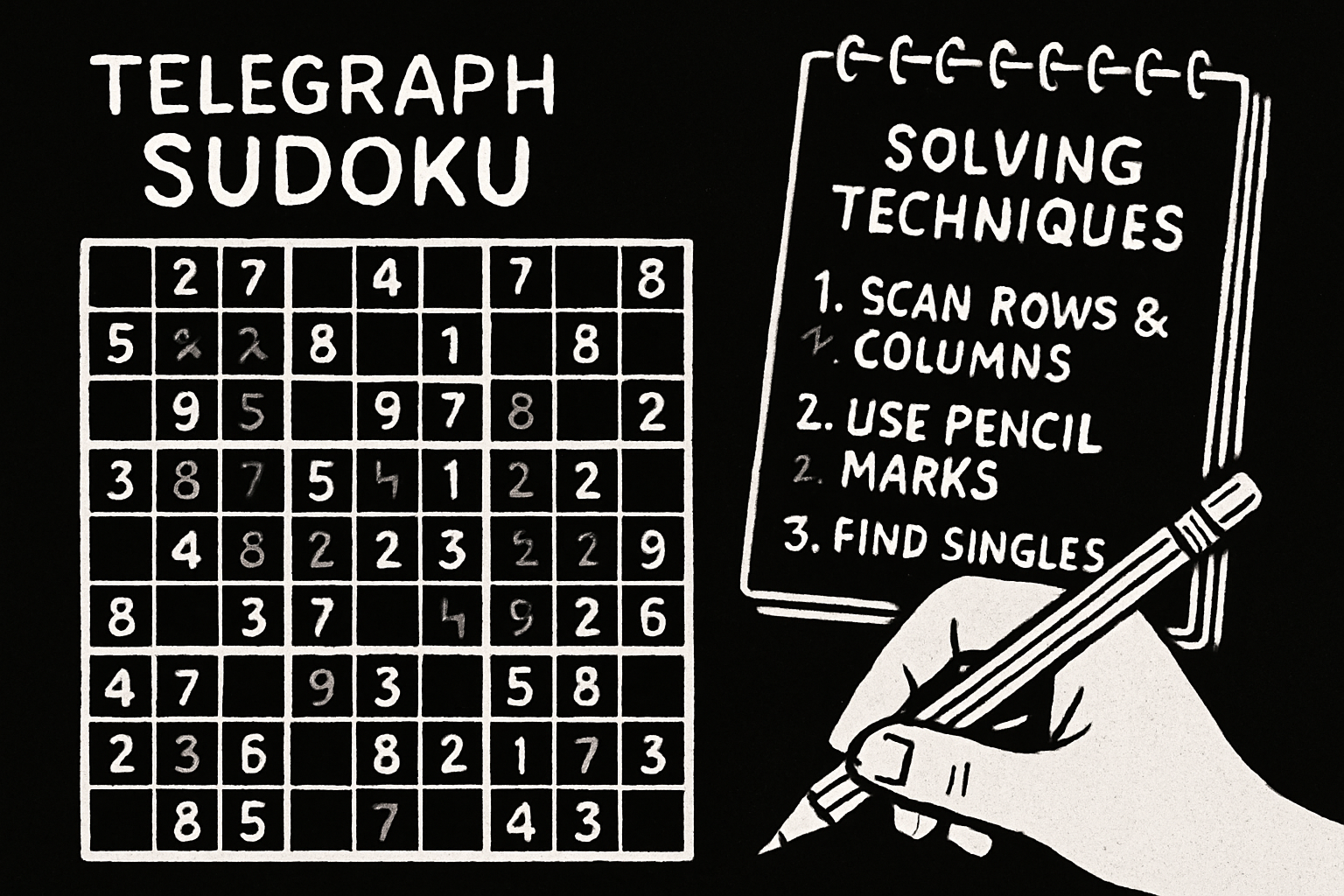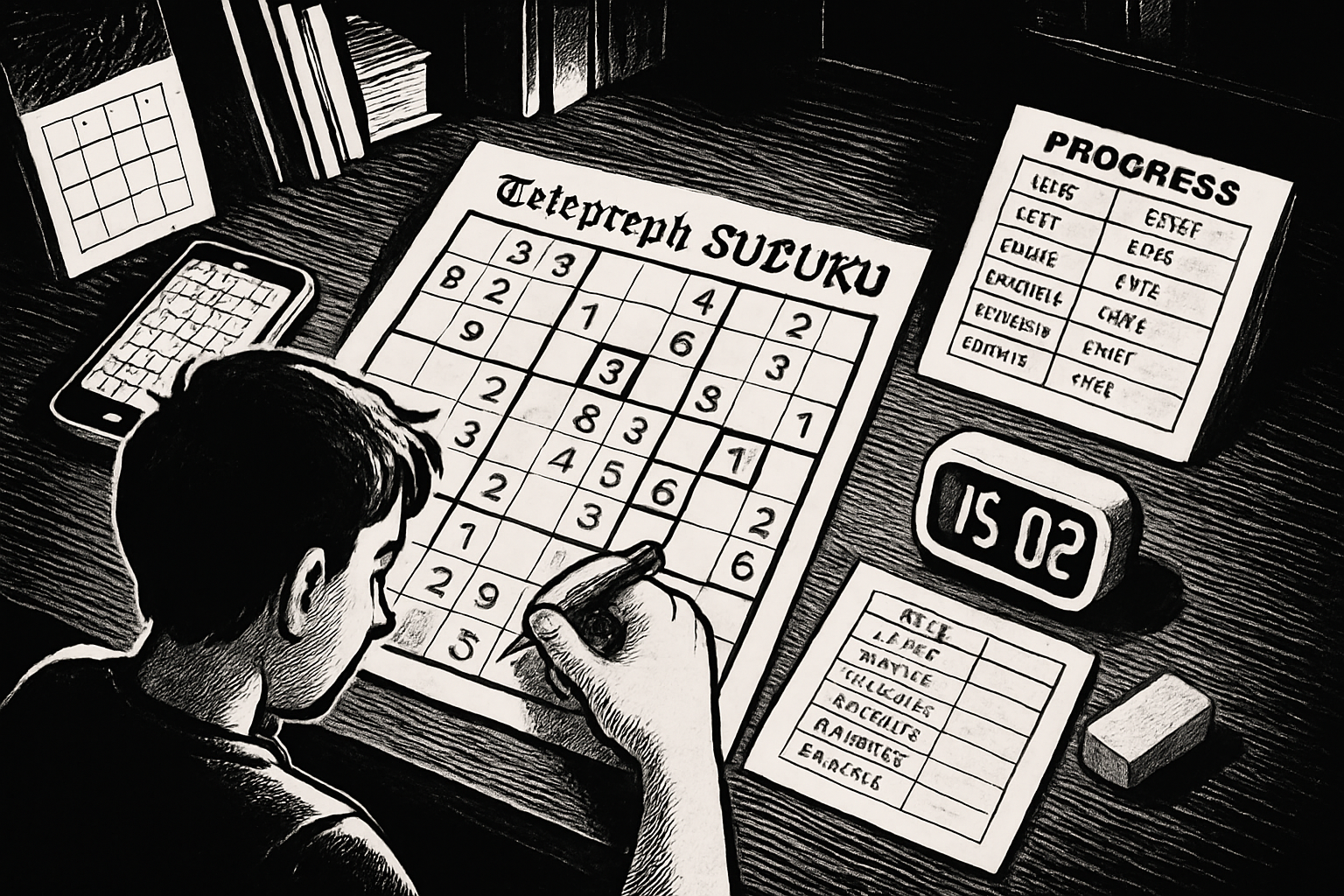Have you ever wondered how Sudoku masters solve puzzles in minutes? Discover the secrets behind Telegraph Sudoku and unlock your puzzle-solving potential.
Telegraph Sudoku has become a favorite for puzzle fans of all ages, thanks to its clever design and daily challenges. This guide will help complete beginners confidently solve Telegraph Sudoku puzzles, with easy-to-follow steps and expert strategies tailored for 2025.
You'll learn the unique Telegraph Sudoku format, essential rules, proven solving techniques, and smart tips to build your skills. Ready to boost your brain and master the art of Telegraph Sudoku? Let’s get started!
Understanding Telegraph Sudoku: What Makes It Unique?
Have you ever noticed how Telegraph Sudoku has become a daily ritual for thousands of puzzle enthusiasts? The story of Telegraph Sudoku began in the early 2000s, right as Sudoku was surging in popularity across the UK. The Telegraph quickly recognized this trend, launching its dedicated Sudoku section that soon became a favorite among readers. Backed by engaging grids and a growing community, Telegraph Sudoku rapidly gained traction, making it a standout choice for both casual and serious solvers worldwide.
What sets Telegraph Sudoku apart from standard Sudoku puzzles? While the classic 9×9 grid remains the foundation, Telegraph Sudoku introduces a variety of formats that keep things fresh. You'll find daily puzzles, weekend challenges, and special themed editions, each designed to test different skill levels. Unlike many generic Sudoku offerings, Telegraph Sudoku often features a more refined selection process, with editors curating puzzles for balance and progression in difficulty. This editorial touch ensures that each Telegraph Sudoku experience feels unique and rewarding, whether you're a beginner or a seasoned solver.
Let’s break down the typical Telegraph Sudoku puzzle layout. Most puzzles use the familiar 9×9 grid, divided into nine 3×3 boxes. However, the Telegraph sometimes offers variants with larger or smaller grids, such as 12×12 or 6×6, especially in special editions. Difficulty levels range from gentle to fiendish, clearly labeled so you can pick the right challenge for your mood. The notations are straightforward: numbers already filled in are bolded, while blank cells await your input. Many solvers use pencil marks to jot down possible candidates, a technique that becomes second nature as you progress.
Here's a quick table highlighting the differences:
| Feature | Telegraph Sudoku | Standard Sudoku |
|---|---|---|
| Formats | Daily, Weekend, Special | Mostly Daily |
| Difficulty Range | Gentle to Fiendish | Easy to Hard |
| Grid Sizes | 9×9, 6×6, 12×12 | Primarily 9×9 |
| Editorial Selection | Curated | Often Random |
| Notation | Clear, Pencil Marks | Varies |
Telegraph Sudoku’s popularity is reflected in its daily engagement—competitor data shows that the Sudoku section attracts thousands of solvers every day. This broad appeal comes from its accessibility: beginners appreciate the clear rules and helpful notations, while advanced players relish the escalating challenges. The editorial team carefully selects puzzles, ensuring a gradual increase in complexity through the week. As you move from Monday’s gentle grids to Saturday’s fiendish ones, you’ll notice the puzzles demanding more sophisticated strategies. If you're eager to build your skills, exploring a Sudoku solving techniques guide can help you approach Telegraph Sudoku with greater confidence and insight.
Ultimately, Telegraph Sudoku stands out because it offers something for everyone. The blend of variety, editorial curation, and a welcoming community makes it the go-to destination for puzzle enthusiasts. Whether you’re just starting or aiming for mastery, Telegraph Sudoku invites you to sharpen your mind and enjoy the journey—one grid at a time.

Essential Rules and Concepts for Beginners
Sudoku might seem mysterious at first, but mastering the basics of telegraph sudoku quickly unlocks a world of logic and satisfaction. Let’s break down the essential rules and concepts you need to know before tackling your first puzzle.

Core Rules of Telegraph Sudoku
At its heart, telegraph sudoku follows the classic rules: each row, column, and 3×3 box must contain the numbers 1 through 9, with no repeats. The puzzle starts with some numbers already filled in, offering clues for your first moves. Your goal is to fill every empty cell so that each number appears only once per row, column, and box.
Unique Variations in Telegraph Sudoku
The Telegraph often spices up its puzzles with special editions and variants. You might encounter diagonal sudoku (where both main diagonals also require unique digits), killer sudoku (using cages with specified sums), or even jigsaw sudoku (with irregularly shaped regions). Always check the instructions for each telegraph sudoku to spot these differences.
Notation, Pencil Marks, and Candidate Elimination
One secret of successful telegraph sudoku solvers is the use of pencil marks. These are small notations in each empty cell showing which numbers could possibly fit. As you fill in more cells and eliminate impossibilities, you erase or update these marks.
For example, if a cell in row 2, column 5 could be a 3, 6, or 9, you’d jot down these numbers in small print. When you find a 3 elsewhere in the same row or box, you can erase it from the candidates. This process, called candidate elimination, is a cornerstone of logical sudoku solving.
Want to see these strategies in action? Check out Sudoku strategies for beginners for a step-by-step look at using pencil marks and basic logic.
Essential Terminology
Here’s a quick reference table of common terms in telegraph sudoku:
| Term | Meaning |
|---|---|
| Naked Pair | Two cells in a unit with the same two candidates; both must contain those numbers. |
| Hidden Single | A number that appears as a candidate only once in a unit; must go there. |
| Candidate | A possible number for a cell, not yet eliminated. |
| Box | A 3×3 region of the grid. |
| Cage | (Killer Sudoku) A group of cells with a given sum. |
Common Mistakes and Myths
Many beginners stumble over similar mistakes in telegraph sudoku. Did you know that 60% of errors are due to rule misinterpretation? Here are pitfalls to watch out for:
- Forgetting to check all three constraints (row, column, box)
- Assuming a puzzle is too hard after a few minutes
- Overwriting pencil marks too soon
- Guessing instead of using logic
Remember, difficulty is not always about fewer clues—sometimes it’s about the logic required!
Building a Strong Foundation
Understanding these foundational rules and concepts is the fastest way to improve at telegraph sudoku. Mastering notation, terminology, and logical elimination not only helps you avoid common mistakes, but also builds your confidence for tackling more challenging puzzles. With these basics in place, you’ll notice your speed and accuracy improve in no time.
Step-by-Step Guide: How to Solve Your First Telegraph Sudoku
Solving your first telegraph sudoku can feel a bit intimidating, but with a focused approach, you’ll be surprised at how quickly you build confidence. This step-by-step guide will walk you through every stage, from understanding the grid to completing your puzzle. Let’s break it down into practical, manageable steps.

Step 1: Setting Up and Understanding the Puzzle
Before you start solving, take a moment to examine the telegraph sudoku grid. Notice the 9×9 structure, divided into nine 3×3 boxes. Each row, column, and box must contain the numbers 1–9 without repeats.
Look for the initial clues: these are the numbers already placed in the grid by The Telegraph’s puzzle editors. Scan the puzzle to spot which rows, columns, or boxes are most filled in. These areas are often the best entry points, as you’ll have more information to work with.
A helpful tip: Use a pencil and eraser when starting out. This lets you make changes as you learn the telegraph sudoku process. Highlight a row or box with the most given numbers and focus your attention there. For example, if you see a box with six numbers already filled, it’s a great place to begin.
Taking your time with setup ensures you understand the telegraph sudoku layout and gives you a solid foundation for the next steps.
Step 2: Filling in Obvious Numbers
Now that you’ve identified your starting point, begin searching for obvious placements—these are called “singles.” In telegraph sudoku, a single is a number that can only fit in one cell within a row, column, or box.
Use scanning techniques: look across each row and column to see which numbers are missing. Sometimes, only one cell remains empty in a line—fill it in confidently. For example, if the number 5 is missing from a box and no 5s appear in the corresponding row or column, you know exactly where it belongs.
Here’s a quick trick: Create a checklist of numbers 1–9 for each box and cross off those already present. This helps you spot which numbers are missing and narrows your options.
Continue this process throughout the telegraph sudoku grid. Filling in these singles gives you a momentum boost and helps unlock more complex placements as you progress.
Step 3: Using Pencil Marks and Notation
As puzzles get trickier, pencil marks become your best friend in telegraph sudoku. Pencil marks are small notations you make in empty cells to show possible candidates for that spot.
Start by writing tiny numbers in the corners of each empty cell, indicating every digit that could fit based on current information. As you fill in more numbers, update your pencil marks—erase eliminated candidates so you can focus on what’s left.
For example, if you initially note that a cell could be 2, 5, or 8, but later place a 2 in that row, erase the 2 from your pencil marks. This visual cue makes it much easier to spot logical moves.
Don’t worry if your grid looks messy at first. Over time, using pencil marks in telegraph sudoku becomes second nature and helps prevent common errors.
Step 4: Advanced Logical Techniques for Beginners
Once you’ve mastered singles and pencil marks, you’re ready to try some beginner-friendly logical techniques in telegraph sudoku. These strategies help you crack the puzzle when simple scanning isn’t enough.
Start with pairs and triples: If two cells in a row, column, or box can only be two specific numbers, those cells must contain those numbers—this is called a “naked pair.” Cross those numbers out as possibilities in other cells in the same unit. The same logic applies for triples.
Block interactions are another powerful tool. If a number can only go in one row or column within a 3×3 box, you can eliminate that number from the same row or column in other boxes. This technique often leads to breakthroughs in telegraph sudoku.
Spotting patterns like naked pairs or hidden singles takes practice. To dig deeper into these and other helpful strategies, check out this excellent overview of Sudoku solving techniques. It covers methods from basic to advanced, making it a great resource as you grow your skills.
Remember, don’t rush—logic is your ally. The more you practice, the more naturally these techniques will come to you in telegraph sudoku.
Step 5: Checking for Errors and Completing the Puzzle
As you near the finish line, it’s crucial to check for errors in your telegraph sudoku. Review each row, column, and box to confirm every number 1–9 appears only once. If you spot duplicates, backtrack to your recent moves and look for missteps.
When you hit a dead end or something doesn’t add up, pause and retrace your steps. Erase recent entries and revisit your pencil marks. Often, a simple oversight is the culprit—a number placed too soon or a candidate ignored.
Take a breather if you get stuck. Fresh eyes can spot mistakes you missed before. Completing your first telegraph sudoku is about patience, accuracy, and learning from each attempt. With every puzzle, you’ll get faster and more confident.
Building Your Skills: Tips, Tricks, and Practice Routines
Starting your Telegraph Sudoku journey can feel overwhelming, but the right approach will transform your learning curve. Whether you’re just beginning or aiming to improve, these tips and routines will help you build lasting skills and confidence in tackling Telegraph Sudoku.

Choosing the Right Telegraph Sudoku Difficulty
Selecting the right Telegraph Sudoku puzzle is key to steady improvement. The Telegraph offers a range of difficulties, from gentle daily puzzles to fiendish weekend challenges. Beginners should start with the easiest levels to develop a solid foundation.
Here’s a quick overview:
| Difficulty | Who It's For | Features |
|---|---|---|
| Easy | Complete beginners | More clues, simple logic |
| Medium | Some experience | Moderate challenge |
| Hard | Advanced solvers | Fewer clues, tricky |
Begin with easy puzzles, solving them consistently. As you grow more comfortable, gradually move up to medium and hard levels. This stepwise approach ensures you’re always challenged but never discouraged. Remember, Telegraph Sudoku difficulty varies, so don’t hesitate to revisit simpler puzzles for practice.
Establishing a Productive Practice Routine
Consistency is the secret to mastering Telegraph Sudoku. Set aside 15–30 minutes daily for practice. Focus on accuracy first, then speed as your confidence grows.
A sample one-week plan for beginners:
- Day 1–2: Solve an easy puzzle, focusing on understanding rules.
- Day 3–4: Try a medium puzzle, using pencil marks.
- Day 5: Review mistakes from previous puzzles.
- Day 6: Attempt a timed easy puzzle.
- Day 7: Mix in a variant or special edition Telegraph Sudoku.
Regular solvers have been shown to improve their completion time by up to 40% in the first month. Always review your puzzles after solving. Look for patterns in your errors and note which strategies worked best.
Time Management and Speed Strategies
As you gain experience with Telegraph Sudoku, time management becomes crucial. Set a timer to add a fun challenge and mimic real competition conditions. Start by giving yourself plenty of time, then gradually reduce it as you improve.
Try these strategies:
- Identify the easiest rows, columns, or boxes first.
- Use pencil marks efficiently to avoid confusion.
- Avoid spending too long on a single cell—move on and return later.
Timed challenges not only boost your speed but also help you stay focused. If you’re interested in the science behind solving puzzles efficiently, you might enjoy reading this Sudoku solving algorithms paper for an in-depth look at different solving methods.
Tracking Progress and Staying Motivated
Tracking your Telegraph Sudoku progress keeps you motivated. Keep a simple notebook or spreadsheet to record:
- Puzzle difficulty
- Time to completion
- Errors made
- New strategies learned
Review your notes weekly. Celebrate improvements, and don’t be discouraged by setbacks—they’re part of the learning process. Join online forums or social media groups to connect with fellow Telegraph Sudoku solvers, share tips, and find support.
Recommended resources include puzzle books, mobile apps, and community forums. Engaging with others and setting small, achievable goals will help you maintain momentum. Over time, you’ll see clear progress and enjoy every challenge the Telegraph Sudoku section has to offer.
Exploring Telegraph Sudoku Variants and Challenges
Sudoku is more than just filling numbers in a grid. If you’re looking to spice up your telegraph sudoku journey, you’ll find a variety of unique variants waiting for you. These special editions challenge your logic in new ways and keep things fresh, whether you’re a casual solver or aiming for mastery.
What Are Telegraph Sudoku Variants?
Telegraph sudoku isn’t just the classic 9×9 grid. The Telegraph offers a range of puzzles, including:
- Killer Sudoku: Combines sudoku logic with arithmetic cages.
- X-Sudoku: Requires numbers 1–9 to appear on both diagonals.
- Jigsaw Sudoku: Features irregular, jigsaw-shaped regions instead of standard boxes.
Each variant tests your brain in a different way. For example, Killer Sudoku adds a math twist, while Jigsaw Sudoku challenges your spatial reasoning. According to competitor insights, about 30% of Telegraph solvers try at least one variant every week.
How to Tackle New Sudoku Challenges
Trying a new telegraph sudoku variant for the first time? Start by reading the rules carefully. Each version introduces its own set of constraints. Here are some tips:
- Begin with easier variants or “gentle” difficulty levels.
- Study example grids and solutions provided by The Telegraph.
- Don’t be afraid to use pencil marks and take your time.
Remember, every variant builds on classic sudoku skills, so your experience will still help you.
Comparing Classic and Variant Telegraph Sudoku Puzzles
Here’s a quick look at how different puzzles stack up:
| Feature | Classic Sudoku | Killer Sudoku | X-Sudoku | Jigsaw Sudoku |
|---|---|---|---|---|
| Regions | 3×3 boxes | 3×3 boxes | 3×3 boxes | Irregular |
| Extra Constraints | None | Cages, sums | Diagonals | Irregular |
| Arithmetic Needed | No | Yes | No | No |
| Unique Strategies | Yes | Yes | Yes | Yes |
Exploring different telegraph sudoku challenges can grow your problem-solving skills. Each variant unlocks a new way to flex your mental muscles.
Tips for Mastering Variants and Where to Play
Want to transition from standard puzzles to variants? Try these strategies:
- Practice daily to build confidence.
- Alternate between classic and variants to reinforce your skills.
- Join online forums or The Telegraph’s community to share tips.
You can find a wide range of telegraph sudoku variants in the Telegraph Puzzles section and on their app. Taking on new challenges is a great way to boost your cognitive flexibility and keep your brain sharp.
The Telegraph Sudoku Community: Events, Competitions, and Support
Jumping into the world of telegraph sudoku isn’t just about solving puzzles alone. There’s a thriving, ever-growing community waiting to welcome both beginners and seasoned solvers. Over the past year, community engagement around telegraph sudoku has increased by 25%, highlighting just how popular and supportive this environment has become.
Online Leaderboards, Forums, and Discussion Groups
One of the best ways to connect with other telegraph sudoku fans is through online leaderboards and forums. These platforms let you track your progress, compare times, and share your experiences with fellow solvers.
Popular discussion groups focus on sharing strategies, hints, and even daily puzzle solutions. Whether you’re looking for advice or just want to chat about your favorite telegraph sudoku puzzle, there’s a space for you. Many beginners find these communities invaluable for learning tips and understanding common solving pitfalls.
Competitions: Annual and Seasonal Events
Telegraph sudoku isn’t just a daily pastime—it’s also a competitive sport! The Telegraph hosts annual and seasonal sudoku competitions, drawing participants from across the UK and beyond.
Events range from beginner-friendly tournaments to advanced challenges. Prizes often include subscriptions, exclusive merchandise, and public recognition. To enter, simply register online and start solving during the event window. These competitions are a fantastic way to test your skills and meet others who share your passion for telegraph sudoku.
Example: Competition Winner Profile
Last year’s Telegraph Sudoku Championship saw a record number of entries. The winner, a university student from Manchester, shared how daily practice and community support helped her clinch the title. Her story is a testament to the inclusive and encouraging spirit of the telegraph sudoku community.
Social Media & Community Support
Social media platforms are buzzing with telegraph sudoku activity. On Twitter, Facebook, and Reddit, you’ll find dedicated groups where solvers post their fastest times, share tricky puzzles, and offer encouragement.
Live streams and video tutorials are becoming increasingly popular, especially for those looking to improve. Community members frequently organize informal challenges, giving everyone a chance to participate and learn together. This digital camaraderie is a big reason why telegraph sudoku continues to grow in popularity.
Benefits, Resources, and How to Get Involved
Being part of the telegraph sudoku community comes with real benefits. Participants often report faster solving times and greater enjoyment thanks to shared learning and motivation.
If you’re ready to get involved, start by exploring The Telegraph’s official Sudoku page. There, you’ll find daily puzzles, event announcements, and links to forums. Don’t hesitate to ask for feedback or join a discussion—everyone was a beginner once.
Here’s a quick table of community resources:
| Resource Type | Where to Find |
|---|---|
| Daily puzzles | Telegraph Sudoku website |
| Forums | Telegraph forums, Reddit, Facebook Groups |
| Competitions | Official Telegraph event page |
| Support & Feedback | Community threads, discussion boards |
Joining the telegraph sudoku community is more than just a hobby—it’s a journey of growth, connection, and fun.
Now that you’ve got the beginner’s roadmap and a toolkit full of Telegraph Sudoku strategies, why not put your new skills to the test? Solving puzzles is the best way to learn, and with every grid you complete, you’ll feel more confident and have a lot of fun along the way. \
If you’re ready to dive in and see how far you’ve come, you can jump straight into real puzzles online—no need to wait or print anything out. \
Let’s get started together: Play Sudoku Online!




